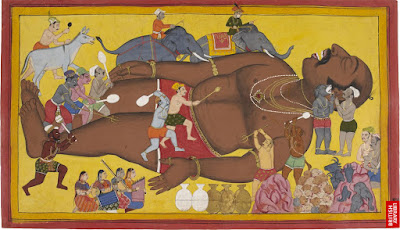Reading Notes: Public Domain Edition: Part D
The plot in Part D hastens. There is more violence and war taking place. With Rama's separation from Sita, the state in which he is able to obliterate his enemy weakens. The rakashasas seemed to have grown stronger, which surprises the reader. The reader is used to Rama being the victor and coming out on top; instead, Rama, his brother, and Sugriva are having to depend on celestial beings and their magical powers. The expected pattern of the story was taking a turn, leaving the reader more intrigued as to what was happening. From this, I gained the understanding that for my story to remain interesting, there must be some aspect of unexplained character interventions or deaths.
The Kumbhakarna Awakening.British Library
In this Part, I could see that some of the stories had a Greek mythology influence. One story specifically, Kumbhakarna, talked about bringing back one of the greatest rakshasa demons. Upon awakening, the demon would devour thousands of apes. This reminded me of the story or Kronos in the Percy Jackson series. Kronos was the oldest Titan, and when he awoke, he devoured every being surrounding him. Furthermore, Part D seems to be a continuous cycle of revenge between the brothers, Lakshmana and Rama, and their foes. The author creates a sort of slippery slope. Rama's wife was taken, so he journeys to find her and encounters demons that he slaughters. However, his enemies become more antagonistic. Rama kills Indrajit. With the death of Indrajit, Ravana aims to avenge his son's death. At this point, the author, yet again, gives the character an aside to express his feelings concerning the events that had just taken place. Ravana was able to lament his child's death. I really think that I will incorporate this aspect into my story for this week.
Bibliography: Dutt et. al. Ramayana Online: Public Domain Edition. Ramayana Online source.




Comments
Post a Comment